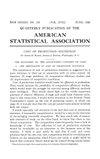An index of the physical volume of production
Quarterly Publications of the American Statistical Association
Pub Date : 1920-09-25
DOI:10.2307/2965282
引用次数: 11
Abstract
pHYSICAL productlon, economically considered, assumes three major forms: agriculture, mining, manufacture. The present study of the physical volume of production recognizes this basic differentiation of industry. In Part I, appearing in the September issue of the REvIEw, an analysis was made of the course of agricultural production in the United States from I879 to I920. In the present part, a parallel study is undertaken of the physical volume of production in mining from I879 to I919. A subsequent installment will deal with the volume of production in manufacture. The methods followed in the analysis of mineral production are those devised and explained in the study of the physical volume of production in agriculture. It will be recalled that two distinct indices of agricultural production were developed: an "unadjusted" and an "adjusted" index. Similar unadjusted and adjusted indices of the physical volume of production in mining are calculated in the present part of the study. A recapitulation of the methods of computing these indices seems desirable. The unadjusted index is of the fixed-base type. It is arrived at by a few comparatively simple steps. The original items of each series are first reduced to percentages of a base for the series, this base being the arithmetic average of the items of the five-year pre-war period, I909-I3. The several commodities are next assigned weights equal to their respective average annual aggregate values during the same base period, I909-I3. Finally a weighted geometric mean of the relatives of each year is computed. These weighted geometric means for the years of the period of study constitute the unadjusted index. The adjusted index is calculated by entirely different methods. The normal or secular trend of each series is first determined. The original items of each series are then expressed as percentages of the corresponding ordinates of the series' line of secular trend. Finally a weighted arithmetic mean of the relatives of each year is calculated, the same weights being used as in the computation of the unadjusted index. The adjusted index consists of these weighted arithmetic means. These methods are made to yield in Part II not only the two indices of mining but, in addition, corresponding indices of the total production of agricultural and mineral raw materials. The unadjusted raw-material index combines the separate unadjusted agricultural and mineral indices as a weighted geometric mean; the adjusted raw-material index combines the separate adjusted indices as a weighted arithmetic mean. In both raw-material indices, the weights assigned to agriculture and mining are proportionate to the aggregate values of agricultural and mineral production in the United States in the last pre-war census year, I909. The raw-material indices are thus only a logical extension of the methods adopted in the construction of the indices for agriculture and mimmng.生产的实物量的指数
从经济角度看,物质生产有三种主要形式:农业、采矿业和制造业。目前对实际产量的研究承认了工业的这种基本差别。第一部分发表在《评论》9月刊上,分析了美国从1979年到1920年的农业生产过程。在本部分中,对1979年至1919年采矿业的实际产量进行了平行研究。后续的分期付款将处理制造中的生产量。在分析矿物生产时所采用的方法是在研究农业生产的实物量时所设计和解释的方法。可以回顾,制定了两种不同的农业生产指数:“未调整”指数和“调整”指数。在本部分的研究中,计算了类似的未调整和调整后的采矿生产实物量指标。对计算这些指数的方法作一个概述似乎是可取的。未调整指标为固定基数型。它可以通过几个相对简单的步骤来实现。每个系列的原始项目首先被简化为该系列基数的百分比,该基数是战前五年(1990 - 1993)期间项目的算术平均值。接下来,这几种商品的权重等于它们各自在同一基期(1999年至1993年)的年平均总值。最后,计算出每年亲属的加权几何平均值。研究期间各年的这些加权几何平均数构成未经调整的指数。调整后的指数是用完全不同的方法计算的。首先确定每个序列的正常或长期趋势。然后将每个系列的原始项目表示为该系列长期趋势线对应坐标的百分比。最后,计算出每年亲属的加权算术平均值,使用与计算未调整指数相同的权重。调整后的指数由这些加权算术平均值组成。在第二部分中,这些方法不仅得到了采矿业的两个指标,而且还得到了农业和矿物原料总产量的相应指标。未经调整的原材料指数将单独的未经调整的农业指数和矿产指数合并为加权几何平均值;调整后的原材料指数将单独调整后的指数合并为加权算术平均值。在这两个原材料指数中,分配给农业和采矿业的权重与美国在战前最后一次人口普查年(1909年)的农业和矿产生产总值成比例。因此,原材料指数只是农业和矿业指数构建方法的逻辑延伸。
本文章由计算机程序翻译,如有差异,请以英文原文为准。
求助全文
约1分钟内获得全文
求助全文

 求助内容:
求助内容: 应助结果提醒方式:
应助结果提醒方式:


